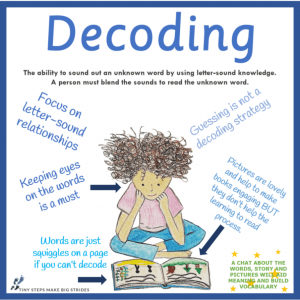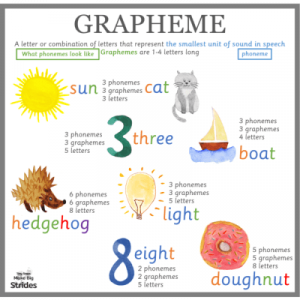Learning to read is a milestone for many children. Most children require some form of explicit teaching. Learning how to read and write involves many steps. Nancy Young (https://www.nancyyoung.ca) describes learning how to read and write as a ladder:

The process of reading involves many skills. These skills include language comprehension and word recognition. It has also been described as a rope of interwoven skills:

Being a skilled reader requires Language Comprehension (background knowledge, vocabulary, language structures, verbal reasoning, literacy knowledge) and Word Recognition (Phonological Awareness, Decoding, and Sight Recognition).

Language Comprehension:
Language Comprehension refers to obtaining meaning from decoded words. In order to do this, we rely on different parts of linguistic knowledge, such as vocabulary, morphology, syntactic structures, and an understanding of the pragmatic aspects of language (Tambyraja & Schmitt, 2020, p.342). An easy way to work on this at home is by using books. Either by reading to your child or taking turns reading together, you can build their language comprehension skills. Asking questions about the characters, the problem/solution in the story and what they think will happen next, helps to open doors for new conversations and literacy connections .
Word Recognition:
Word recognition allows the reader to perceive a word based on a familiar grouping of letters. Skills in phonological awareness, decoding, and sight recognition of familiar words are required to recognize words.
Phonological awareness: We have a great section on phonological awareness and resources here.

Decoding: involves knowledge of letters and sounds. Using decodable books, or books that have limited and specific phonic patterns that your child is familiar with can help your child practice reading.
Links to Free decodable books:
https://www.speldsa.org.au/speld-phonic-books
https://portal.flyleafpublishing.com/learners-resources/
https://halfpintkids.com/online-materials/

Sight Recognition: requires the understanding of graphemes, the letter or combination of letters that represent a phoneme (the smallest unit of sound in speech). Sight words are words that you recognize automatically and instantly, easily without needing to sound out the word. Sight words can be regular and decodable or irregular. You can practice sight words at home using orthographic mapping. Some sight words are high frequency words that aren’t easily decodable. Help your child learn to read and spell these words using Heart Word Magic.
Resources for supporting your child in learning how to read
Reading Ready guide for parent and caregivers
Free Literacy Resources for Parents
https://www.readingrockets.org/
https://www.reallygreatreading.com/
http://www.signsandsoundsphonics.ca/
Resources for older students:
https://www.phonicbooks.com/resources/phonic-infographics/curriculum-words